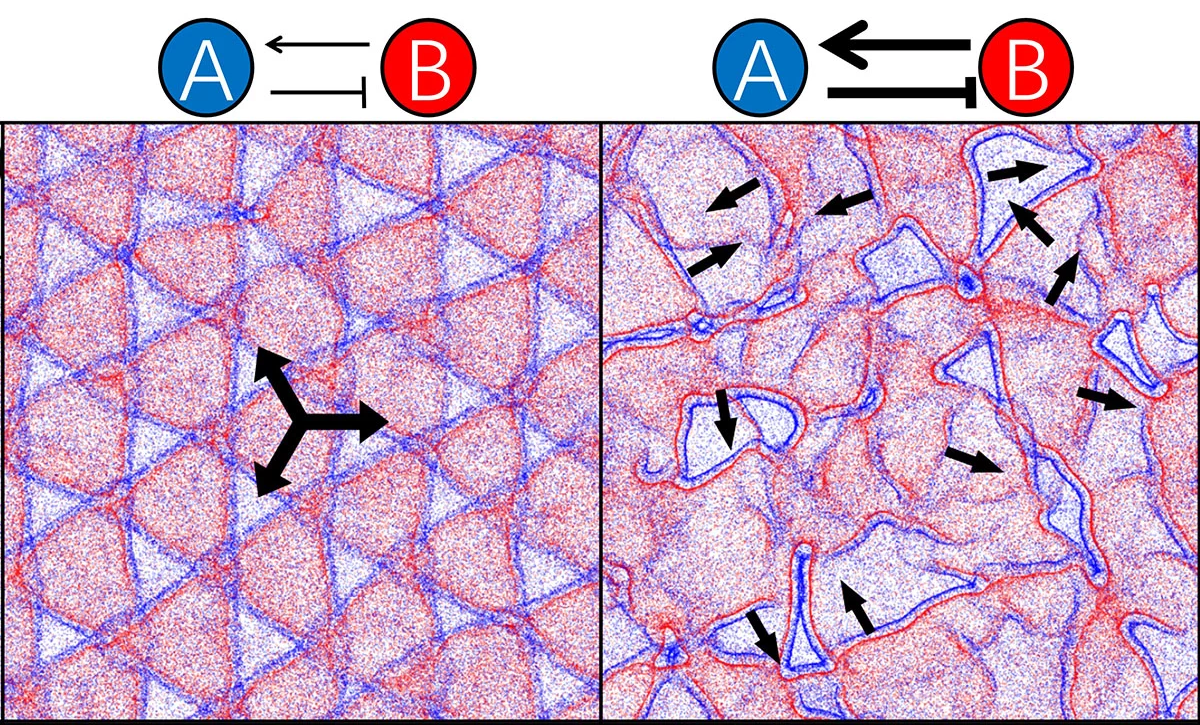The Max Planck Institute for Dynamics and Self-Organization (MPI-DS) has put forward a new model highlighting the role of chasing interactions between two bacterial species in creating structural patterns.
 Depending on the chase-and-avoid interaction between two species, A and B, different patterns of self-organization can evolve on the global level. Image Credit: © MPI-DS / LMP
Depending on the chase-and-avoid interaction between two species, A and B, different patterns of self-organization can evolve on the global level. Image Credit: © MPI-DS / LMP
This model outlines how interactions at the individual level can lead to a broader self-organization of species on a global scale. These findings offer valuable insights into the fundamental mechanisms underlying collective behavior in biological systems.
In a recent study, researchers from the Department of Living Matter Physics at MPI-DS formulated a model that ecidates communication pathways within bacterial populations. Bacteria exhibit an inherent organizational structure by detecting the concentration of chemicals in their surroundings and adjusting their movements accordingly.
The Structure Only Becomes Visible on a Higher Level
We modeled the non-reciprocal interaction between two bacterial species. This means that species A is chasing species B, whereas B is aiming to repel from A.”
Yu Duan, Study First Author, Department of Living Matter Physics, Max Planck Institute for Dynamics and Self-Organization
The researchers determined that the chase-and-avoid interaction alone is adequate to create structural patterns. The specific pattern formed is contingent on the intensity of this interaction. This discovery complements an earlier study in which a model was suggested that incorporated intraspecies interactions among the bacteria to produce patterns.
In this new model, which also accounts for bacterial motility, the formation of complex superstructures involving millions of individuals does not necessitate adhesion or alignment among the bacteria.
Although the bacterial population dynamics show a global order, this is not the case on the individual bacterial level. In particular, a single bacterium seems to move in a disordered way, with the structure becoming visible only on a higher level, which is very fascinating.”
Benoît Mahault, Group Leader, Department of Living Matter Physics, Max Planck Institute for Dynamics and Self-Organization
A General Model for Collective Behavior
Furthermore, the model is adaptable to encompass more than two species, expanding the range of potential interactions and resulting patterns. Importantly, its applicability extends beyond bacteria and can be applied to a wide array of collective behaviors.
These encompass light-controlled microswimmers, social insects, animal groups, and robotic swarms. Consequently, this study offers comprehensive insights into the mechanisms underpinning the development of large-scale structures within networks comprising numerous components.
Source:
Journal reference:
Duan, Y., et al. (2023). Dynamical Pattern Formation without Self-Attraction in Quorum-Sensing Active Matter: The Interplay between Nonreciprocity and Motility. Physical Review Letters. doi.org/10.1103/physrevlett.131.148301.